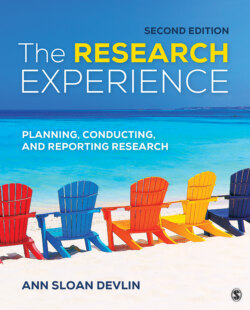Читать книгу The Research Experience - Ann Sloan Devlin - Страница 158
Summary
ОглавлениеThis chapter has provided a general overview of research design as well as of internal and external validity and the components of each. You know the distinction between research where relationships are assessed and research where causal inferences can be drawn. The distinction has been made between IVs and DVs and between true IVs and quasi-IVs. We have seen how a study that started out with a correlational approach can be transformed into one that takes an experimental (causal) approach. In thinking about the number of participants needed for research, you should now be familiar with the concepts of power and effect size, and you should be able to explain the difference between Type I and Type II errors. We have reviewed the classic list of threats to internal validity from Campbell and Stanley (1963) and have expanded that list to include demand characteristics, the beliefs/attitudes of participants, the effectiveness of the cover story, and the effectiveness of manipulation checks. Finally, we have considered the different kinds of locations for research, from the laboratory to the field.
In later chapters, we will examine each of the different research designs (and associated statistics) in more depth.
If you have not had time to consider them earlier, here is the list of Revisit and Respond questions from this chapter.
3.1Explain how a quasi-IV differs from an IV and the difference in language appropriate in a correlational versus an experimental study.Identify the IV (manipulated variable) and the DV (effect or outcome variable) in the following description:“The campers were randomly assigned to two different cabins right next to each other, A and B; the camp director wanted to test the effectiveness of different kinds of mosquito netting (MN) and placed MN with white nylon fabric in Cabin A and MN with black nylon fabric in Cabin B. There was a significant difference in the number of bug bites reported by the campers in the two different cabins.”
3.2In your own words, explain the difference between Type I and Type II errors.
3.3Explain why having sufficient power is important for a study.What are the four factors from Howell (2013) that affect the power of a research design?What is the most common way to increase power?In your own words, describe what an effect size is. How is power related to effect size?
3.4Of the threats to internal validity listed by Campbell and Stanley (1963), where do you have the most control? The least control?Give an example of a demand characteristic.What are the different role attitudes participants can have, according to Adair (1973)?What is the difference between a cover story and a manipulation check?
3.5Explain the difference between external validity and ecological validity.
